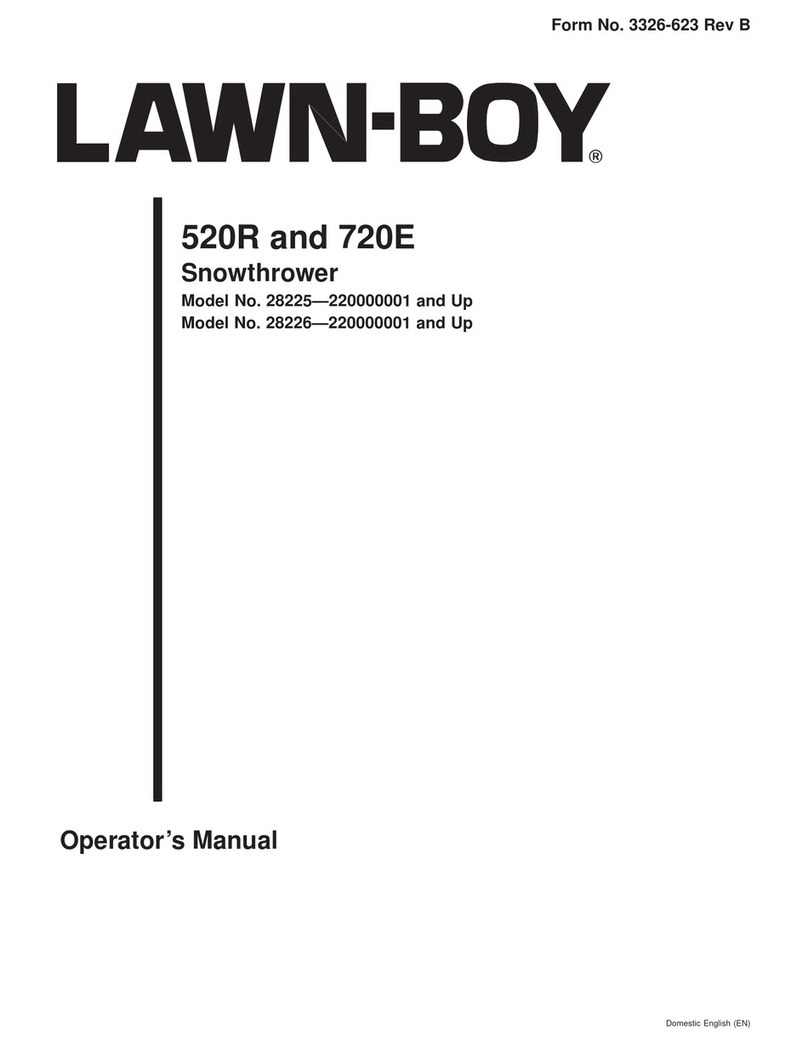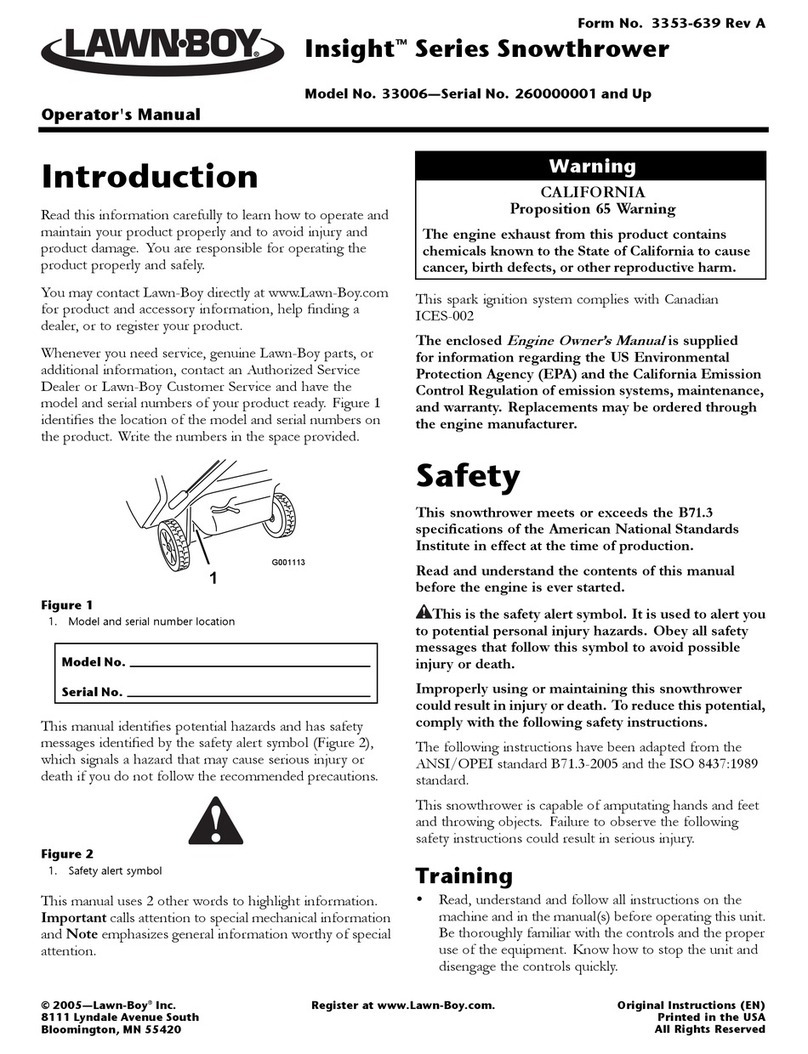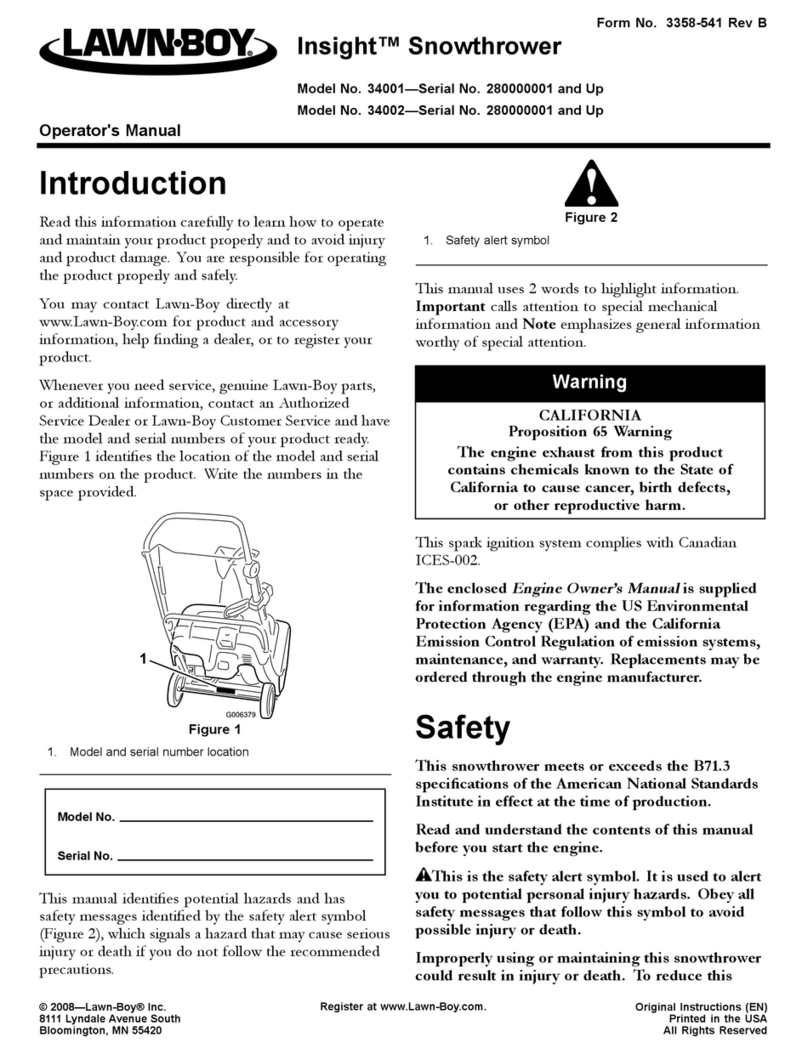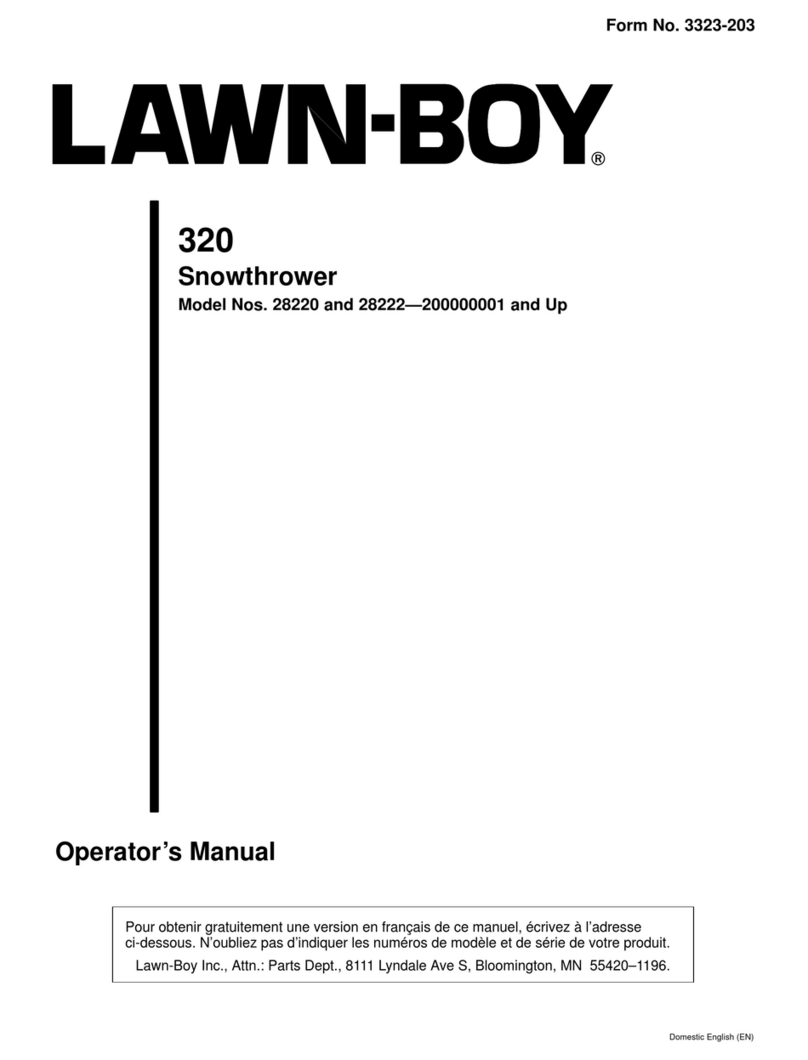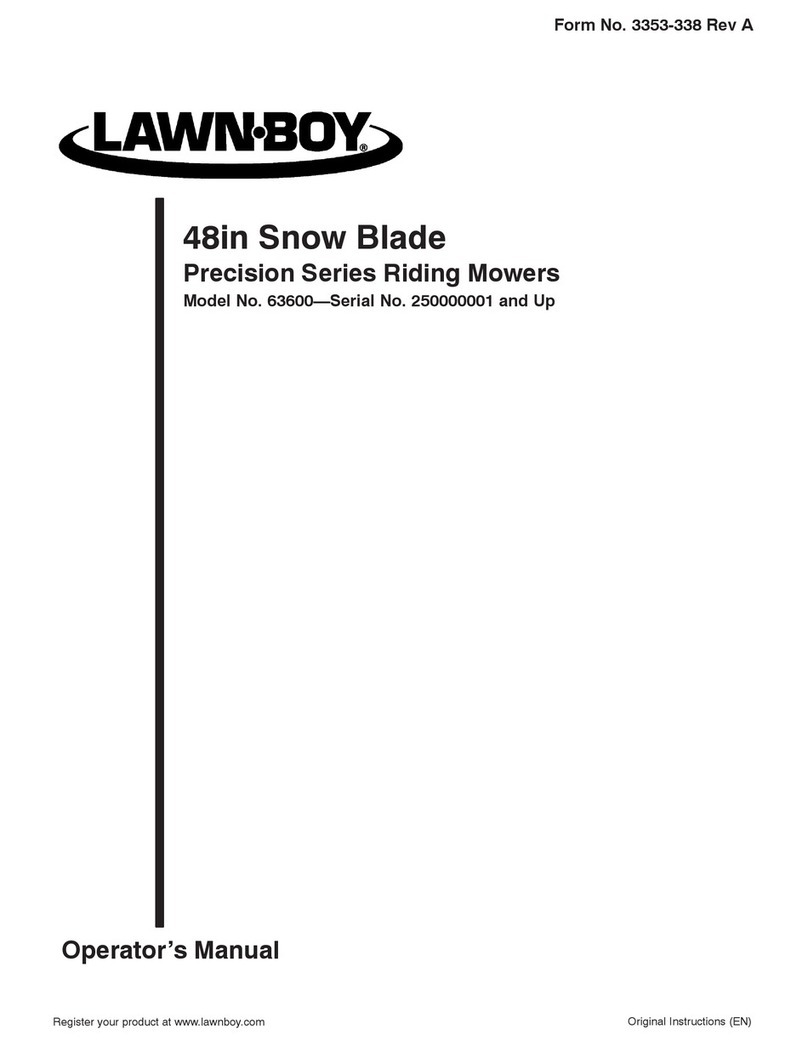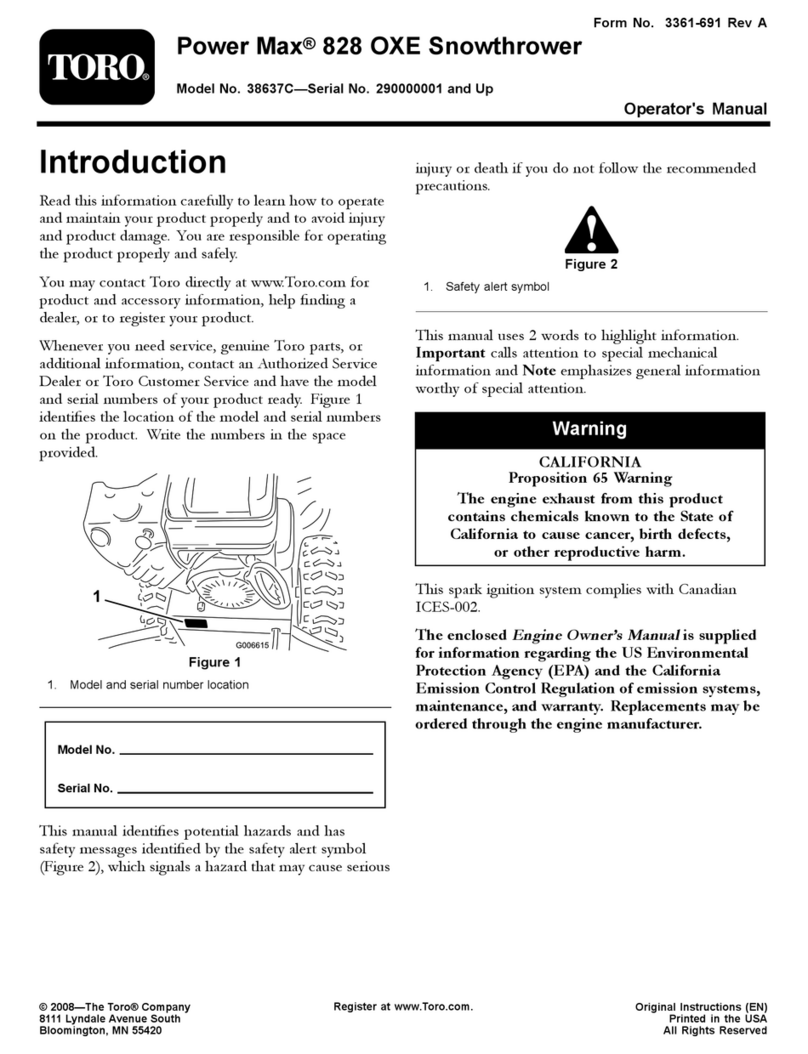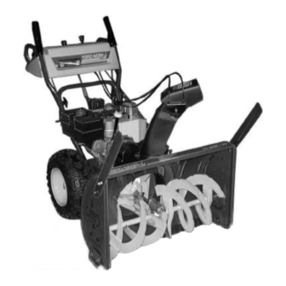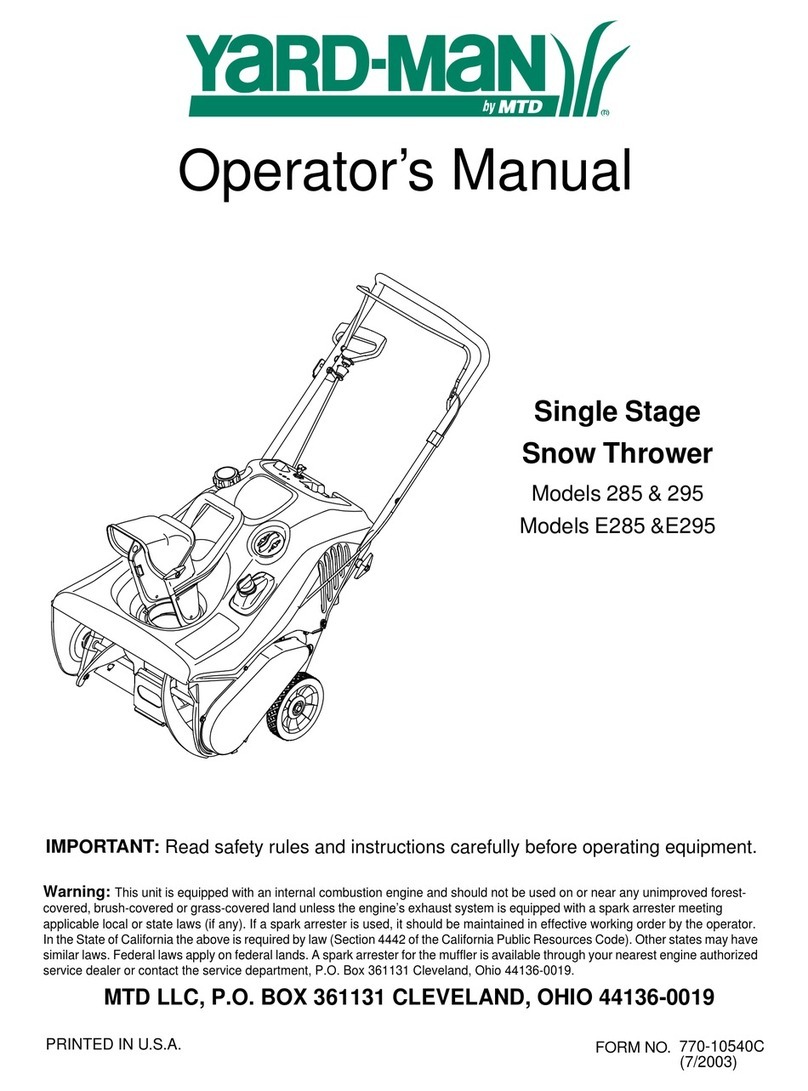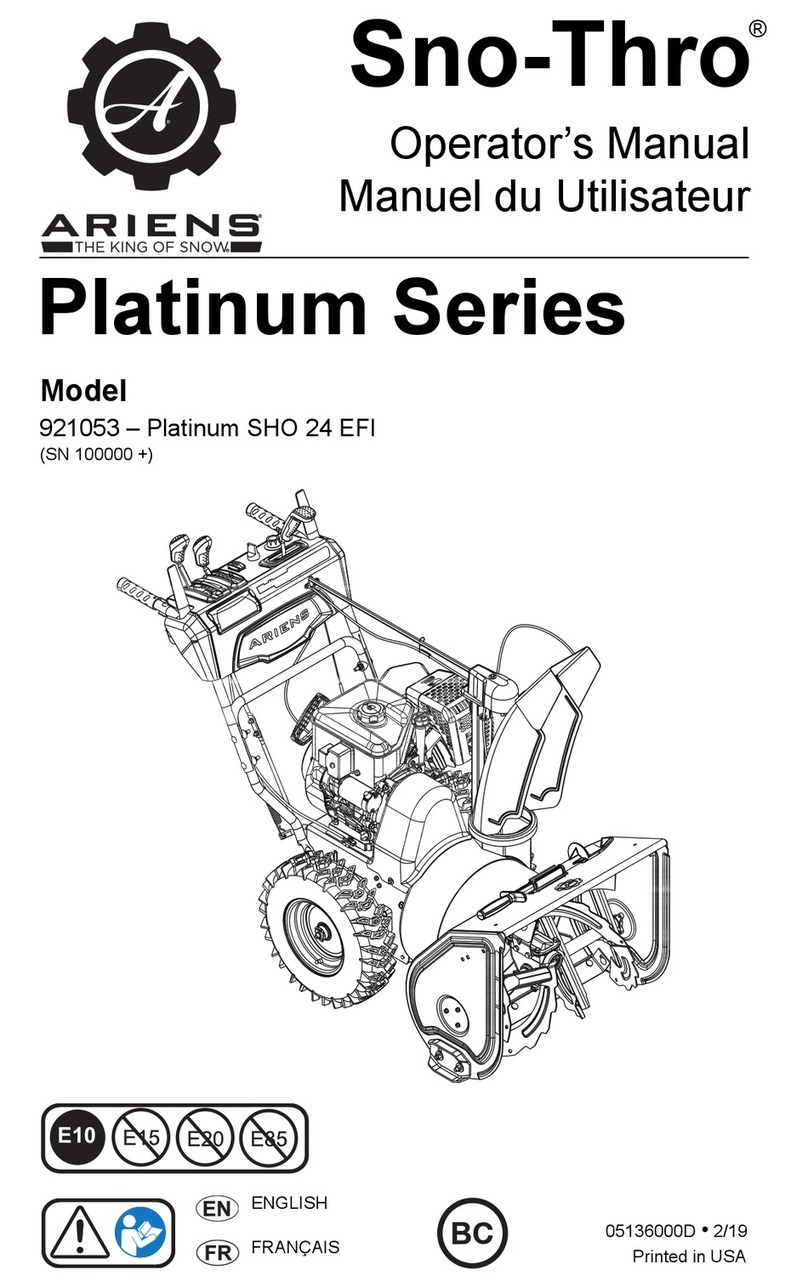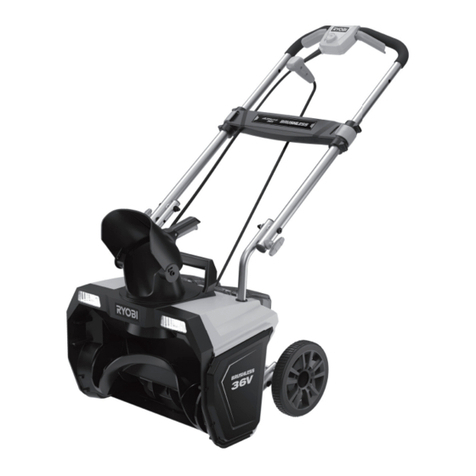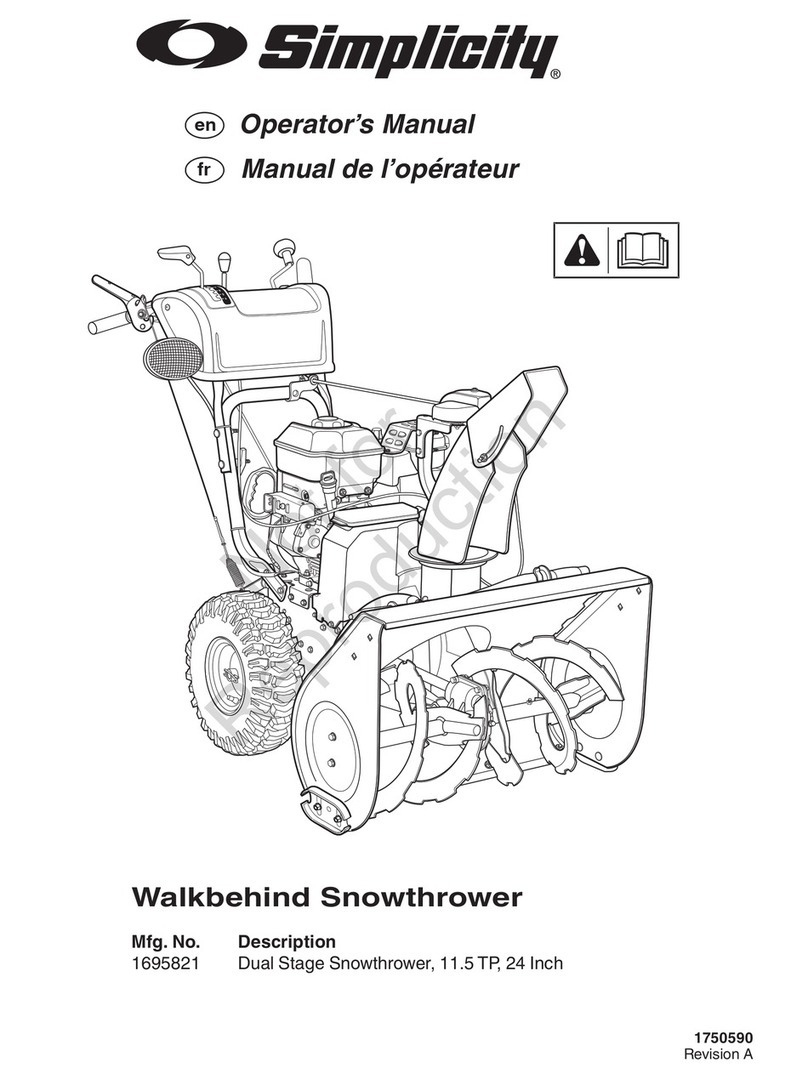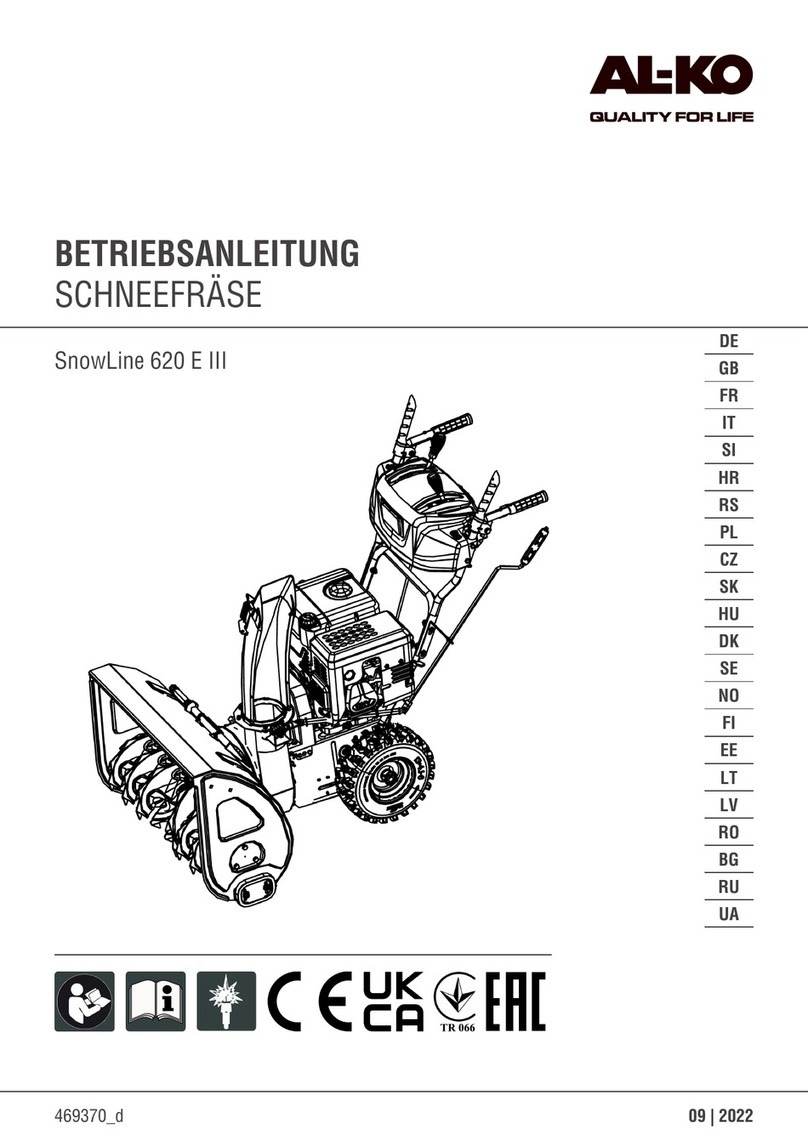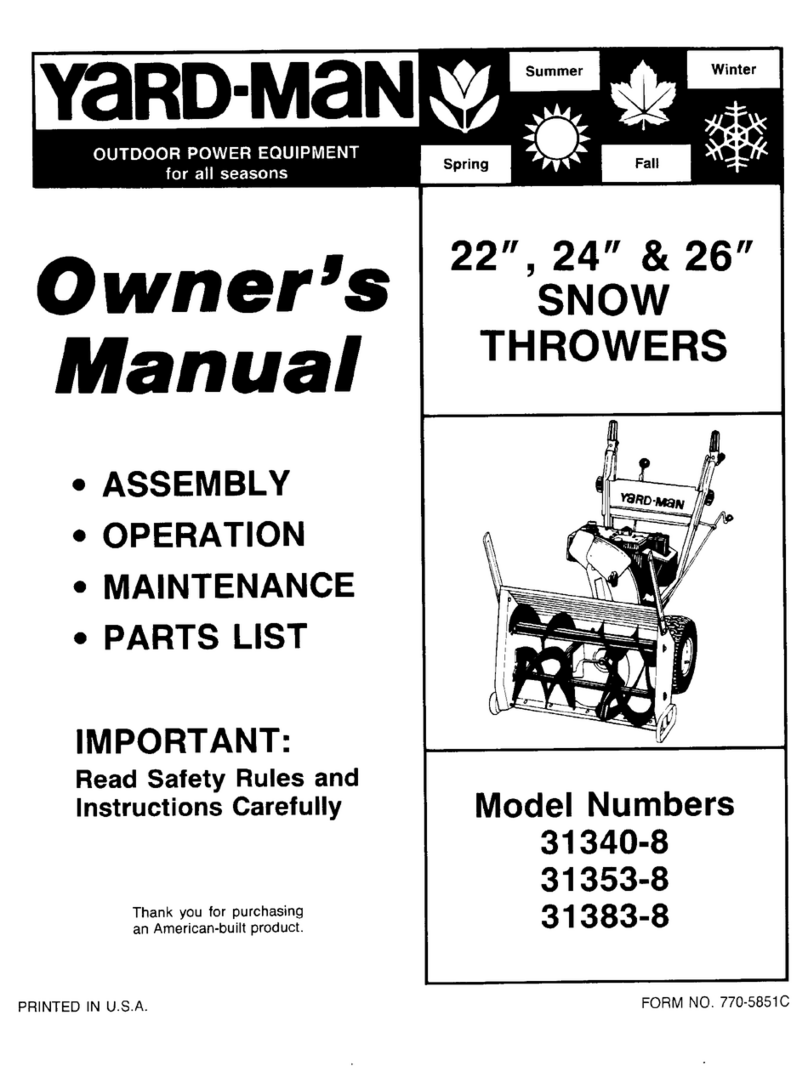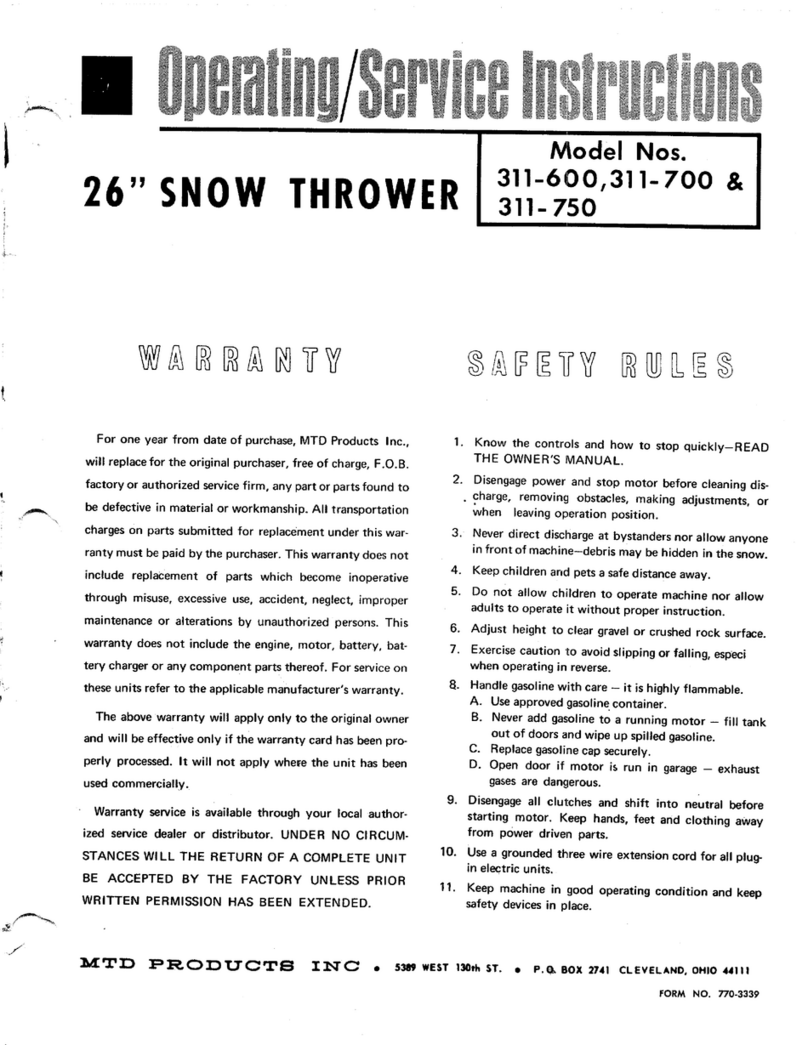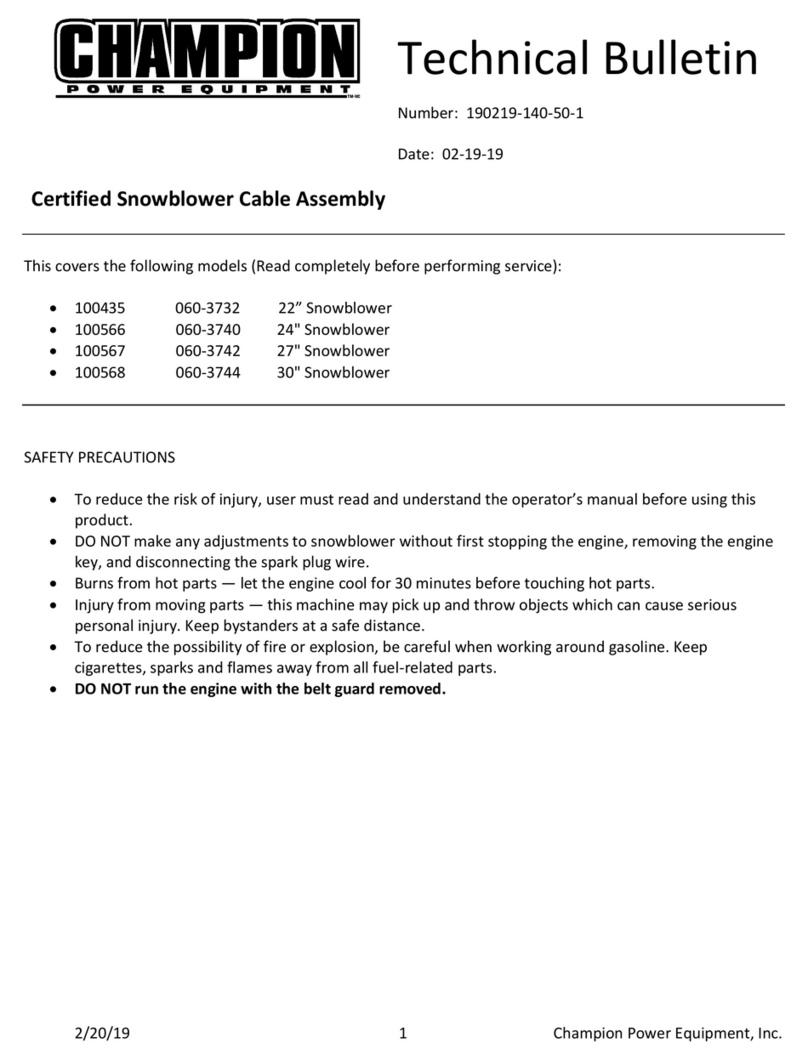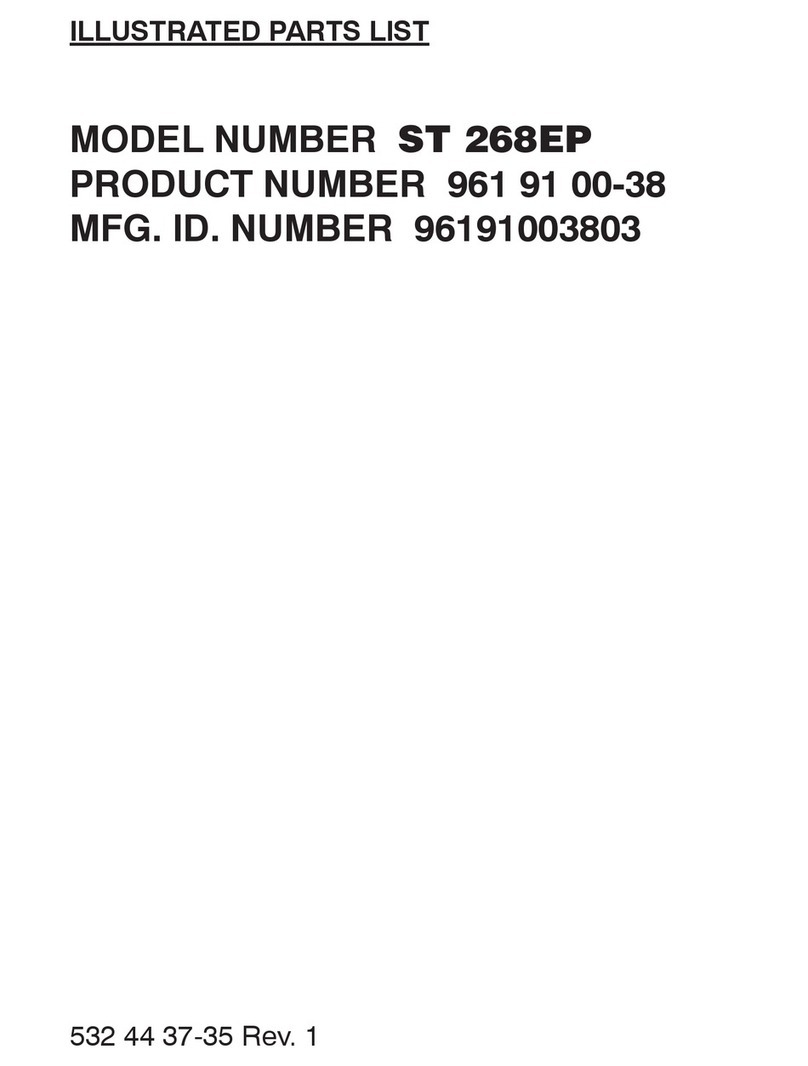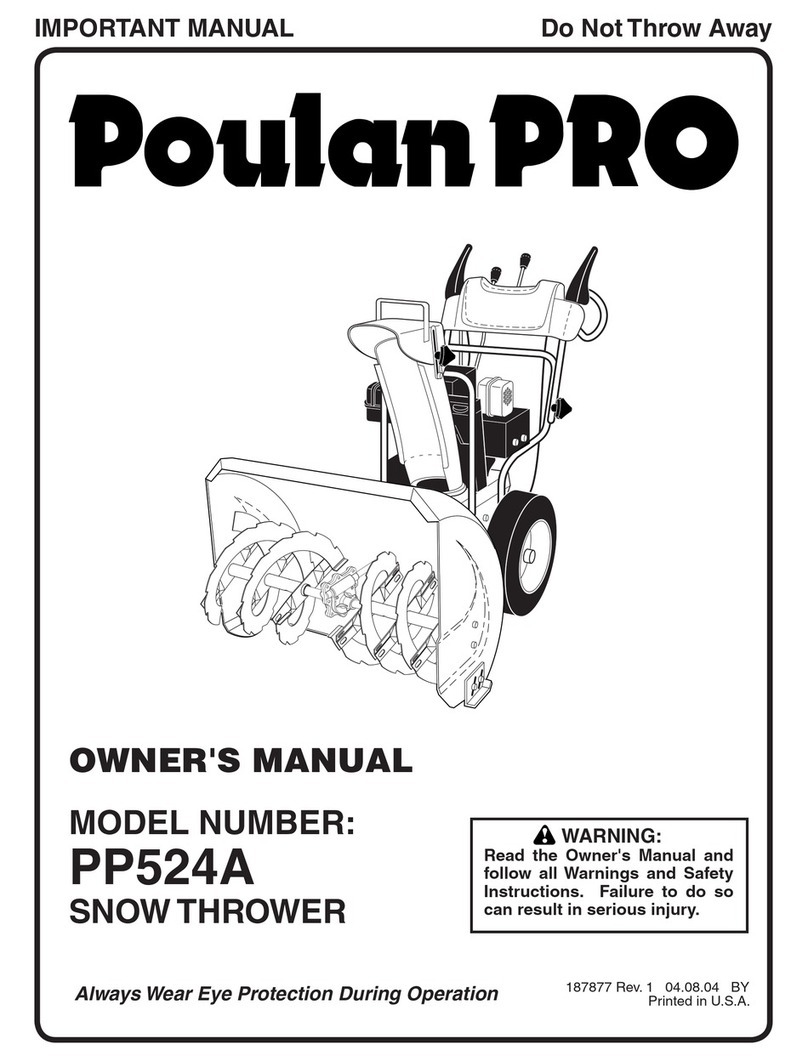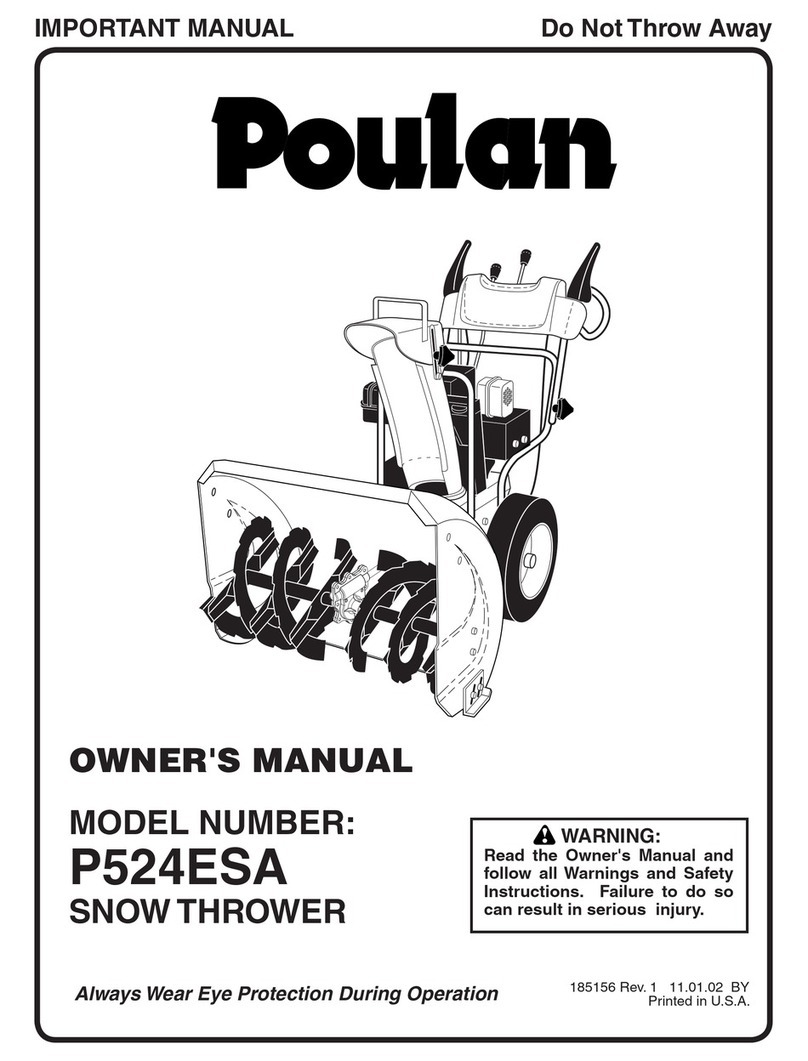Lawn-Boy 522R User manual

Operator’s Manual
Pour
obtenir gratuitement une version en français de ce manuel, écrivez à l’adresse
ci-dessous. N’oubliez pas d’indiquer les numéros de modèle et de série de votre produit.
Lawn-Boy Inc., Attn.: Parts Dept., 81
1
1 L
yndale A
ve S, Bloomington, MN 55420–1
196.
English (EN)
FORM NO. 3323-205 Rev A
522R
Snowthrower
Model No. 28230—200000001 and Up

Lawn Boy, Inc. - 1999
All Rights Reserved Printed in USA
2
Contents
Page
Introduction 2.
. . . . . . . . . . . . . . . . . . . . . . . . . . . . . . . .
Safety 3
. . . . . . . . . . . . . . . . . . . . . . . . . . . . . . . . . . . . . .
General Snowthrower Safety
3
. . . . . . . . . . . . . . . . .
Lawn-Boy Snowthrower Safety
4
. . . . . . . . . . . . . . .
Safety Decals and Instructions
5
. . . . . . . . . . . . . . . .
Loose Parts
6
. . . . . . . . . . . . . . . . . . . . . . . . . . . . . . . . . .
Accessories 7
. . . . . . . . . . . . . . . . . . . . . . . . . . . . . . . . .
Assembly 7
. . . . . . . . . . . . . . . . . . . . . . . . . . . . . . . . . . .
Install Handle
7
. . . . . . . . . . . . . . . . . . . . . . . . . . . . .
Install Speed Selector Rod
8
. . . . . . . . . . . . . . . . . . .
Install T
raction Rod
8
. . . . . . . . . . . . . . . . . . . . . . . .
Install Auger Drive Control Linkage
8
. . . . . . . . . . .
Install Chute Control Rod
9
. . . . . . . . . . . . . . . . . . .
Secure Chute Deflector
9
. . . . . . . . . . . . . . . . . . . . .
Check T
ire Pressure
10
. . . . . . . . . . . . . . . . . . . . . . . .
Before Starting
10
. . . . . . . . . . . . . . . . . . . . . . . . . . . . . . .
Fill Crankcase W
ith Oil
10
. . . . . . . . . . . . . . . . . . . . .
Fill Fuel T
ank With Gasoline
11
. . . . . . . . . . . . . . . . .
Operation 11
. . . . . . . . . . . . . . . . . . . . . . . . . . . . . . . . . . .
Controls 11
. . . . . . . . . . . . . . . . . . . . . . . . . . . . . . . . .
Starting/Stopping Engine
12
. . . . . . . . . . . . . . . . . . . .
Operating T
ips 13
. . . . . . . . . . . . . . . . . . . . . . . . . . . .
Adjusting Skids And Scraper Blade
13
. . . . . . . . . . . .
Maintenance 14
. . . . . . . . . . . . . . . . . . . . . . . . . . . . . . . . .
Draining Gasoline
14
. . . . . . . . . . . . . . . . . . . . . . . . .
Lubricating Snowthrower
15
. . . . . . . . . . . . . . . . . . .
Changing Crankcase Oil
15
. . . . . . . . . . . . . . . . . . . .
Auger Gear Box Grease
16
. . . . . . . . . . . . . . . . . . . . .
Adjusting Auger/Impeller Drive Belt
16
. . . . . . . . . .
Replacing Auger/Impeller Drive Belt
16
. . . . . . . . . .
Replacing T
raction Drive Belt
17
. . . . . . . . . . . . . . . .
Adjusting T
raction Drive
18
. . . . . . . . . . . . . . . . . . . .
Adjusting Speed Selector
18
. . . . . . . . . . . . . . . . . . . .
Replacing Spark Plug
18
. . . . . . . . . . . . . . . . . . . . . . .
Storage 19
. . . . . . . . . . . . . . . . . . . . . . . . . . . . . . . . . . . . .
Warranty 20
. . . . . . . . . . . . . . . . . . . . . . . . . . . . . . . . . . . .
WARNING
The engine exhaust fr
om this pr
oduct contains
chemicals known to the State of California to
cause cancer
, birth defects, or other r
eproductive
harm.
Introduction
Thank you for purchasing a Lawn-Boy product.
All of us at Lawn-Boy want you to be completely satisfied
with your new product, so feel free to contact your local
Authorized Service Dealer for help with service, genuine
Lawn-Boy parts, or other information you may require.
Whenever you contact your Authorized Service Dealer or
the factory
, always know the model and serial numbers of
your product. These numbers will help the Service Dealer
or Service Representative provide exact information about
your specific product. Y
ou will find the model and serial
number decal located in a unique place on the product
(Fig. 1).
m–2592
1
Figure 1
1. Model
and serial number decal
For
your convenience, write the product model and serial
numbers in the space below
.
Model No:
Serial No.
Read
this manual carefully to learn how to operate and
maintain your product correctly
. Reading this manual will
help you and others avoid personal injury and damage to
the product. Although Lawn-Boy designs, produces and
markets safe, state-of-the-art products, you are responsible
for using the product properly and safely
. Y
ou are also
responsible for training persons who you allow to use the
product about safe operation.
The Lawn-Boy warning system in this manual identifies
potential hazards and has special safety messages that help
you and others avoid personal injury
, even death.
DANGER, W
ARNING and CAUTION are signal words
used to identify the level of hazard. However
, regardless
of the hazard, be extremely careful.
DANGER
signals an extreme hazard that will cause
serious injury or death if the recommended precautions
are not followed.
WARNING
signals a hazard that may cause serious injury
or death if the recommended precautions are not followed.

3
CAUTION
signals a hazard that may cause minor or
moderate injury if the recommended precautions are not
followed.
T
wo other words are also used to highlight information.
“Important” calls attention to special mechanical
information and “Note” emphasizes general information
worthy of special attention.
The left and right side of the machine is determined by
standing behind the handle in the normal operator
’s
position.
Safety
T
o ensur
e maximum safety
, best performance, and to
gain knowledge of the pr
oduct, it is essential that you
and any other operator of the snowthr
ower r
ead and
understand the contents of this manual befor
e the
motor is ever started. Pay particular attention to the
safety alert symbol
which means CAUTION,
W
ARNING OR DANGER — “personal safety
instruction.” Read and understand the instruction
because it has to do with safety
. Failur
e to comply with
instruction may r
esult in personal injury
.
The snowthrower is designed and tested to of
fer
reasonably safe service; however
,
failur
e to comply with
the following instructions may r
esult in personal
injury.
General
Snowthrower Safety
The
following instructions have been adapted from the
ANSI/OPEI standard B71.3—1995 and ISO standard
8437:1989. Information or terminology specific to
Lawn-Boy snowthrowers is enclosed in parenthesis.
Training
•
Read the operator
’
s manual carefully
. Be thoroughly
familiar with the controls and the proper use of the
equipment. Know how to stop the unit and disengage
the controls quickly
.
•
Never allow children to operate the equipment. Never
allow adults to operate the equipment without proper
instruction.
•
Keep the area of operation clear of all persons,
particularly small children and pets.
•
Exercise caution to avoid slipping or falling, especially
when operating in reverse.
Preparation
•
Thoroughly inspect the area where the equipment is to
be used and remove all doormats, sleds, boards, wires,
and other foreign objects.
•
Disengage all clutches and shift into neutral before
starting the engine.
•
Do not operate the equipment without wearing
adequate winter garments. W
ear footwear which will
improve footing on slippery surfaces.
•
Handle fuel with care; it is highly flammable.
•
Use an approved fuel container
.
•
Never add fuel to a running or hot engine.
•
Fill fuel tank outdoors with extreme care. Never
fill fuel tank indoors.
•
Replace gasoline caps securely and wipe up spilled
fuel.
•
Use only the power cord supplied with the
snowthrower and a receptacle appropriate for use with
the cord for electric starting motors.
•
Adjust the collector (auger) housing height to clear
gravel or crushed rock surface (this is not necessary on
single-stage snowthrowers).
•
Never attempt to make any adjustments while the
engine is running, except where specifically
recommended by manufacturer (Lawn-Boy).
•
Let engine and machine adjust to outdoor temperatures
before starting to clear snow
.
•
The operation of any powered machine can result in
foreign objects being thrown into the eyes. Always
wear safety glasses or eye shields during operation or
while performing an adjustment or repair
.
Operation
•
Do not put hands or feet near or under rotating parts.
Keep clear of the dischar
ge opening at all times.
•
Exercise extreme caution when operating on or
crossing gravel drives, walks, or roads. Stay alert for
hidden hazards or traf
fic.
•
After striking a foreign object, stop the engine, remove
the wire from the spark plug, thoroughly inspect the
snowthrower for any damage, and repair the damage
before restarting and operating the snowthrower
.
•
If the unit should start to vibrate abnormally
, stop the
engine and check immediately for the cause. V
ibration
is generally a warning of trouble.
•
Stop the engine whenever you leave the operating
position, before unclogging the collector
(auger)/impeller housing or dischar
ge guide (chute),
and when making any repairs, adjustments, or
inspections.
•
When cleaning, repairing, or inspecting, make certain
the collector (auger/rotor blades)/impeller and all
moving parts have stopped. Disconnect the spark-plug

4
wire, and keep the wire away from the plug to prevent
accidental starting. Disconnect the cable on electric
motors.
•
Do not run the engine indoors, except when starting it
and for moving the snowthrower in or out of the
building. Open the outside doors; exhaust fumes are
dangerous.
•
Do not clear snow across the face of slopes. Exercise
extreme caution when changing direction on slopes.
Do not attempt to clear steep slopes.
•
Never operate the snowthrower without proper guards.
plates or other safety protective devices in place.
•
Never operate the snowthrower near glass enclosures,
automobiles, window wells, drop-of
fs, etc. without
proper adjustment of the snow dischar
ge angle. Keep
children and pets away
.
•
Do not overload the machine capacity by attempting to
clear snow at too fast a rate.
•
Never operate the machine at high transport speeds on
slippery surfaces. Look behind and use care when
moving in reverse.
•
Never direct dischar
ge at bystanders or allow anyone
in front of the unit.
•
Disengage power to the collector (auger/rotor
blades)/impeller when snowthrower is transported or
not in use.
•
Use only attachments and accessories approved by the
manufacturer of snowthrower (Lawn-Boy), such as
wheel weights, counterweights, cabs, etc. (Refer to
your Authorized Service Dealer for accessories
available for your snowthrower
.)
•
Never operate the snowthrower without good visibility
or light. Always be sure of your footing, and keep a
firm hold on the handles. W
alk; never run.
Maintenance and storage
•Check
all fasteners at frequent intervals for proper
tightness to be sure the equipment is in safe working
condition.
•
Never store the machine with fuel in the fuel tank
inside a building where ignition sources are present
such as hot water and space heaters, clothes dryers,
etc. Allow the engine to cool before storing in any
enclosure.
•
Always refer to this operator
’
s manual for important
details if the snowthrower is to be stored for an
extended period.
•
Maintain or replace safety and instruction labels, as
necessary.
•
Run the machine a few minutes after throwing snow to
prevent freeze-up of the collector (auger)/impeller
.
(W
ith the engine running, pull the recoil starter handle
several times.)
Lawn-Boy
Snowthrower Safety
The
following list contains safety information specific to
Lawn-Boy products or other safety information that you
must know that is not included in the ANSI or ISO
standards.
•
The r
otating impeller or auger can cut off or injur
e
fingers or hands.
Stay behind the handles and away
from the dischar
ge opening while operating the
snowthrower
.
Keep your face hands, feet, and any
other part of your body or clothing away fr
om
concealed, moving, or r
otating parts.
•
Before adjusting, cleaning, repairing, and inspecting
the snowthrower, and before unclogging the dischar
ge
chute,
stop the engine, r
emove the key
, and wait for
all moving parts to stop
. Also, pull the wire of
f of
the spark plug and keep it away from the plug to
prevent accidental starting.
•
Use a stick,
not your hands
to remove obstructions
from the dischar
ge chute.
•Before
leaving the operator
’
s position behind the
handles, stop the engine, remove the key
, and wait for
all moving parts to stop.
•
Do not wear loose fitting clothing that could possibly
get caught in moving parts.
•
If a shield, safely device, or decal is damaged,
illegible, or lost, repair or replace it before beginning
operation. Also, tighten any loose fasteners.
•
Do not
smoke while handling gasoline.
•
For two-stage snowthrowers, use the lower gear and, if
applicable, the rear wheel position when operating on
slopes.
•
Do not
use the snowthrower on a roof.
•
Do not touch the engine while it is running or soon
after it is stopped because the engine will be hot
enough to cause a burn. Do not add oil or check the
oil level in the crankcase when the engine is running.
•
Perform only those maintenance instructions described
in this manual. Before performing any maintenance,
service, or adjustment, stop the engine, remove the key
and pull the wire from the spark plug, keeping it away
from the plug to prevent accidental starting. If major
repairs are ever needed, contact your Authorized
Lawn-Boy Service Dealer
.
•
Do not over speed the engine by changing the
governor settings.

5
•
When storing the snowthrower for more than 30 days,
drain the gasoline from the fuel tank to prevent a
potential hazard. Store gasoline in a safety approved,
red metal container
. Remove the key from the ignition
switch before storing the snowthrower
.
•T
o ensure the best performance and safety
, purchase
only genuine Lawn-Boy replacement parts and
accessories to keep the Lawn-Boy all Lawn-Boy
.
Do
not use “W
ill Fit” r
eplacement parts and
accessories as they could cause a safety hazard.
""
" " "
#
#
""
"$
!
$
Safety
Decals and Instructions
Safety
decals and instructions are easily visible to the operator and are located near any area of potential danger
. Replace
any decal that is damaged or lost. Decals with T
ecumseh part numbers must be obtained from T
ecumseh Product Company
.
Decals with Lawn-Boy part numbers must be obtained from Lawn-Boy Inc.
ON
AUGER HOUSING
(Lawn-Boy Part No. 53–7670)
ON CHUTE CONTROL BRACKET
(Lawn-Boy Part No. 63–3510)
ON ENGINE
(T
ecumseh Part No. 371
19)
NEXT T
O PRIMER
(T
ecumseh Part No. 36501)

6
ON CONTROL P
ANEL
(Lawn-Boy Part No. 95–2698)
ON CONTROL P
ANEL
(Lawn-Boy Part No. 94–8098)
ON ENGINE
(T
ecumseh Part No. 35282)
ON DISCHARGE CHUTE
(Lawn-Boy Part No. 94–8079)
Loose
Parts
Part Qty Use
Cotter
Pin
1
Install on Speed Selector Rod
Flat W
asher 1
Install on Speed Selector Rod
Capscrews & Curved W
ashers 4
Install Handle
Clevis Pin
1
Cotter Pin
1
Install Auger & T
raction Drive Control Rod
Flange Nut
2
g
Capscrew & Locknut
1
Install Chute Control Rod
Locknut & Pyramidal W
asher 1
Install Chute Control Rod
Carriage Bolt
1
Rubber W
asher 1
Friction Plate
1
Secure Chute Deflector
Large Flat W
asher 1
Secure Chute Deflector
Curved W
asher 1
Locknut 1
Key 1
Use in Ignition Switch
Registration Card
2
Used to V
alidate Product W
arranty
Specifications
and design subject to change without notice.

7
Accessories
Description Part
Number
110 Vac Electric Starter Kit 38036
Tire Chain Kit 56-2700
Drift Breaker Kit 37-7022
Assembly
Note:
Determine left and right sides of snowthrower by
standing in the normal operating position.
Install
Handle
1. Remove
tie straps securing control rods to handle.
2.
Remove the axle pins from both wheels (Fig. 2) and
slide the wheels outward on the axle approximately
one inch to make clearance for assembly of handles.
653
Figure 2
1. Handle
2. Capscrews
and curved
washers
3.
Axle pinf
3. Thread
a flange nut (flange side down) onto traction
rod located on left handle (Fig. 3).
4.
Hold handles in installation position and insert traction
rod through loop in lower traction rod (Fig. 3).
654
Figure 3
1. Traction
rod
2. Loop 3.
Lower traction rod
4.
Flange nuts
5. Position
left handle against side of unit, align handle
mount holes with holes in side plate, and secure with
two capscrews and curved washers until finger tight
(Fig. 2).
Note:
Concave side of curved washer goes against
outside of handle.
Repeat procedure on right side. Make sure handles are
at same height before tightening handle screws on both
sides of unit.
6.
Reinstall the wheels. Note that there are two holes in
each end of the axle. Axle pins are installed through
holes in the wheel hub and through inner
hole of axle
(Fig. 4).
Note:
If snowthrower is to be equipped with optional
tire chains, wheels must be pinned through outer
axle
holes.
473
Figure 4
1. Axle
pin
2.
Outer axle hole
3.
Inner axle hole and wheel
hub

8
Install
Speed Selector Rod
1. Pull
speed selector arm (Fig. 5) to the fully “out”
position and move speed selector (Fig. 6) on control
panel to the R (REVERSE) position to ease assembly
.
648
Figure 5
1. Speed
selector arm
2.
Speed selector rod
3.
Flat washer and cotter pin
879
Figure 6
1.
Auger control lever
2. T
raction control lever
3.
Speed selector
4.
Speed selector rod
2. Install
speed selector rod into selector arm, add one
flat washer on the selector rod and secure with cotter
pin (Fig. 5).
Install
T
raction Rod
1. Thread
a flange nut (flange side up) onto bottom of
traction control rod below loop in lower traction rod
(Fig. 3).
2.
Adjust the two flange nuts up or down on the traction
control rod until the distance between the top of the
handgrip and the bottom of the traction control lever
(Fig. 6 and 7) is approximately 4
#/8
inches.
This is a
pr
eliminary setting only
.T
ighten the two flange nuts
finger tight.
665
Figure 7
1. Traction
control lever
2. Handgrip 3.
Approximately 4
#/8
inches
4.
One to two inches
3. Move
speed selector (Fig. 6) into third gear
.
Note:
If speed selector will not move into third gear
,
an adjustment is necessary: refer to Adjusting Speed
Selector
, page 18. Make the adjustment before
continuing with assembly
.
4.
Slowly pull machine backward while slowly
depressing traction control lever toward handle.
Adjustment is correct when wheels stop turning and
the distance between the top of the handgrip and the
bottom of the traction control lever is one to two
inches (Fig. 7). Readjust the two flange nuts, if
necessary
, to obtain this dimension and then tighten
the two flange nuts securely
.
Install
Auger Drive Control
Linkage
1. Loosen
jam nut above clevis on upper control rod
(Fig. 8).
2.
Align holes in clevis and lower control rod and insert
clevis pin (Fig. 8).
649
Figure 8
1. Jam
nut
2. Clevis
3.
Upper control rod
4.
Lower control rod
5.
Clevis pin
6.
Cotter pin

9
3. Check
the distance between the top of the handgrip
and the bottom of the auger control lever (Figs. 6 & 9).
Distance should be approximately four inches.
This is
a pr
eliminary setting only
.
665
Figure 9
1. Auger
control lever
2. Handgrip 3.
Approximately four inches
4.
One to two inches
4. Compress
auger control lever slowly toward handgrip.
The amount of force to compress the lever will
increase noticeably when slack is removed from the
drive belt (approximately one-half of lever
movement). Adjustment is correct when the force
begins
to increase and the distance between the top of
the handgrip and the bottom of the auger control lever
is one to two inches.
Note:
If force does not noticeably increase, remove the
belt cover (refer to Replacing Auger/ Impeller Drive
Belt, steps 1-2, page 16) and measure the one to two
inch dimension above the handgrip at the point where
the slack is removed from the auger drive belt.
5. T
o adjust the distance, remove clevis pin, loosen jam
nut and thread clevis up or down to increase or
decrease distance between handgrip and auger control
lever (Fig. 8).
6.
When adjustment is correct, install clevis pin and
secure it in place with the cotter pin. T
ighten jam nut
to secure clevis (Fig. 8).
Install
Chute Control Rod
1. Assemble
chute control bracket and rod to left side of
handle with capscrew and locknut. Leave locknut
loose until assembly is completely mounted (Fig. 10).
886
Figure 10
1. Chute
control bracket
and rod
2.
Capscrew and locknut
2. Apply
No. 2 general purpose grease to worm gear
.
Next, mount worm gear and bracket to mounting
flange and secure with pyramidal washer and locknut
(Fig. 1
1).
3.
Slide worm gear into teeth of chute retaining ring and
tighten locknut (Fig. 1
1).
658
Figure 1
1
1. Worm
gear and bracket
2.
Bolt, pyramidal washer
and locknut
3.
Mounting flange
4. Tighten
the locknut securing chute control bracket
against left handle (Fig. 10).
5.
Check operation of chute control rod. Move worm
gear slightly outward if binding is evident.
Secure
Chute Deflector
1. Pivot
deflector upward and back until deflector stop
passes over lip on top of chute.

10
2.
Secure left side of deflector to dischar
ge chute using
parts as illustrated in Figure 12. Make sure rubber
washer and friction plate are positioned between chute
and deflector and friction plate tabs fit into holes in
deflector
. See Figure 12 for proper installation
sequence of parts.
Note:
Concave side of curved washer goes against
lar
ge flat washer
.
667
Figure 12
1. Chute
2. Deflector
3. Carriage
bolt
4.
Rubber washer
5.
Friction plate
6.
Large flat washer
7.
Curved washer
8. Locknut
3. Tighten
nuts on both sides of deflector
. Do not
over
-tighten nuts so that excessive force is required to
change deflector angle.
Check
T
ire Pressure
IMPORTANT:
Check pr
essur
e of tir
es because they
ar
e over
-inflated at the factory for shipping. Ther
efore,
befor
e the snowthr
ower is operated, r
educe pr
essur
e in
both tir
es to 7-15 psi equally
.
Before
Starting
ENGINES
WHICH ARE CER
TIFIED T
O COMPL
Y
WITH CALIFORNIA AND U.S. EP
A EMISSION
REGULA
TIONS FOR ULGE ENGINES:
Are certified
to operate on regular unleaded gasoline. Include the
following emission control system(s): EM, TWC (if so
equipped); Do not include any user adjustable features –
therefore no other adjustments are needed.
Fill
Crankcase W
ith Oil
The
engine is shipped from the factory without oil in the
crankcase. Therefore, before starting the engine, oil must
be added to the crankcase.
IMPORTANT
: Check level of oil every 5 operating
hours or each time unit is used. Initially, change oil
after the first 2 hours of operation; ther
eafter
, under
normal conditions, change oil after every 25 hours of
operation or annually
, whichever comes first.
1.
Move unit to a level surface to ensure an accurate oil
level reading.
2.
Clean area around dipstick to prevent foreign matter
from entering filler hole when dipstick is removed.
3.
Remove dipstick from crankcase (Fig. 13).
883
Figure 13
1. Filler
hole
2. Dipstick 3.
Fuel tank cap
4. Slowly
pour 21 ounces (0.621 liters) of SAE 5W–30 or
SAE 10 oil into the filler hole. The engine uses any
high-quality deter
gent oil having the American
Petroleum Institute (API) “service classification”—SF
,
SG, SH or SH/CD.
Note:
Dipstick must be fully installed to ensure
accurate gauging of oil level. DO NOT OVERFILL.
POUR OIL SLOWL
Y.

11
Fill
Fuel T
ank W
ith Gasoline
DANGER
POTENTIAL
HAZARD
•
In certain conditions gasoline is extr
emely
flammable and highly explosive.
WHA
T CAN HAPPEN
•
A fir
e or explosion fr
om gasoline can burn you,
others, and cause pr
operty damage.
HOW T
O A
V
OID THE HAZARD
•
Use a funnel and fill the fuel tank outdoors, in
an open ar
ea, when the engine is cold. W
ipe up
any gasoline that spills.
•
Do not fill the fuel tank completely full. Add
gasoline to the fuel tank until the level is 1/4” to
1/2” (6 mm to 13 mm) below the bottom of the
filler neck. This empty space in the tank allows
gasoline to expand.
•
Never smoke when handling gasoline, and stay
away fr
om an open flame or wher
e gasoline
fumes may be ignited by a spark.
•Stor
e gasoline in an appr
oved container and
keep it out of the r
each of childr
en.
•
Never buy mor
e than a 30-day supply of
gasoline.
Use clean, fresh lead-free gasoline, including
oxygenated
or
reformulated
gasoline, with an octane rating of 85 or
higher. T
o ensure freshness, purchase only the quantity of
gasoline that can be used in 30 days. Use of lead-free
gasoline results in fewer combustion chamber deposits
and longer spark plug life. Use of premium grade fuel is
not necessary
.
IMPORTANT
: NEVER USE METHANOL
,
GASOLINE CONT
AINING METHANOL
,
GASOHOL CONT
AINING MORE THAN 10%
ETHANOL, PREMIUM GASOLINE OR WHITE
GAS BECAUSE ENGINE FUEL SYSTEM DAMAGE
COULD RESUL
T.
Lawn-Boy recommends that Lawn-Boy 2+4
r
Fuel
Conditioner be used regularly during operation and
storage. Lawn-Boy 2+4
r
Fuel Conditioner cleans the
engine during operation and prevents gum-like varnish
deposits from forming in the engine during storage.
Note:
A fuel stabilizer/conditioner is most ef
fective when
mixed with fresh gasoline.
DO NOT USE FUEL ADDITIVES OTHER THAN
THOSE MANUF
ACTURED FOR FUEL
STABILIZA
TION DURING ST
ORAGE SUCH AS
LA
WN-BOY 2+4
r
FUEL CONDITIONER.
LA
WN-BOY DOES NOT RECOMMEND
ST
ABILIZERS WITH AN ALCOHOL BASE SUCH
AS ETHANOL OR METHANOL. ST
ABILIZERS
SHOULD NOT BE USED T
O TR
Y T
O ENHANCE
THE POWER OR PERFORMANCE OF MACHINE.
1.
Clean area around the fuel tank cap (Fig. 13). Remove
cap from fuel tank. Using unleaded, regular gasoline,
fill tank to within 1/4” to 1/2” (6 to 13 mm) from the
top of the tank, not into the filler neck. This space is
for expansion of fuel. Do not fill tank full. Reinstall
fuel tank cap.
Operation
Controls
Auger/Impeller Drive Contr
ol
(Fig. 14)—Control has
two positions: ENGAGE and DISENGAGE. T
o engage
both auger and impeller
, compress lever against right
handgrip. T
o disengage, release lever
.
T
raction Contr
ol
(Fig. 14)—T
o engage traction (wheel
drive), lever must be compressed against left handgrip. T
o
stop traction, release lever
.
Speed Selector
(Fig. 14)—The control has four positions:
reverse, 1, 2 and 3. T
o change speeds, move gear shift to
position desired. Lever will lock in notch at each speed
selection. Use positions 1, 2 or 3 depending on snow
conditions.
m–4037
Figure 14
1. Auger/impeller
drive
control
2. T
raction control
3.
Speed selector
4.
Discharge chute control
5.
Fuel shut–of
f valve
6.
Chute deflector handle
Ignition
Switch
(Fig. 15)—Insert key before starting
engine with the recoil starter
. T
o stop engine, remove key
.
Throttle
(Fig. 15)—Moving the throttle upward increases
engine speed.

12
Choke
(Fig. 15)—Rotate choke to FULL choke position
to start a cold engine. As engine warms up, move choke
gradually to OFF
.
Primer
(Fig. 15)—Press primer to pump a small amount
of gasoline into engine for improved cold weather
starting.
m-4045
Figure 15
1. Choke
2. Primer
3. Throttle
4. Recoil
starter
5.
Ignition switch
Fuel Shut-Off Valve
(Fig. 14)—V
alve is located under
fuel tank. Close valve to stop fuel flow from fuel tank and
open valve to allow fuel to flow to the carburetor
. Close
valve when snowthrower is not in use.
Discharge Chute Contr
ol
(Fig. 14)—Rotate dischar
ge
chute control clockwise to move dischar
ge chute to the
left and counterclockwise to move chute to the right.
Recoil Starter
(Fig. 15)—Recoil starter is on back side of
engine. Pull recoil starter to start engine.
Chute Deflector Handle
(Fig. 14)—Deflector handle is
on top of dischar
ge chute, and it is used to control height
of the snow stream.
Starting/Stopping
Engine
If
engine is operated when temperature is +40
_
F (4
_
C) or
higher
, remove carburetor heater box (Fig. 16). However
,
the heater box must be reinstalled when temperature falls
below +40
_
F (4
_
C). T
o remove heater box:
1.
Remove (2) Phillips screws and (1) hex head screw
securing heater box in place (Fig. 16). Pull choke knob
of
f choke rod (Fig. 15).
880
Figure 16
1. Carburetor
heater box
2.
Phillips screws
3.
Hex head screw
2. Lift
heater box up and away from the engine, and
reinstall choke knob on mounting pin.
IMPORTANT
: Check auger and impeller to ensur
e
that both parts ar
e not fr
ozen but fr
ee to r
otate.
Also, make sur
e discharge chute is not obstructed.
USE A STICK, NOT YOUR HAND, T
O REMOVE
ANY OBSTRUCTIONS.
Starting
1.
Move throttle (Fig. 15) to F
AST.
2.
Open fuel shut-of
f valve below fuel tank (Fig. 14).
3.
Rotate choke (Fig. 15) to full choke position.
4.
Insert ignition key (Fig. 15).
5.
Cover hole in center of primer with thumb and push
primer slowly three times.
DO NOT PRIME IF THE
ENGINE HAS BEEN RUNNING AND IS HOT
.
Note:
Excessive priming may cause flooding of engine
and failure to start.
6.
Grasp recoil starter handle (Fig. 15) and pull it out
slowly until positive engagement results; then pull
vigorously to start the engine. Keep firm grip on
starter handle and return the rope slowly
.
Note:
If engine does not start or if temperature is
–10_
F (–23
_
C) or below
, additional priming may be
required. After each additional prime, try to start the
engine before priming again.
7.
After engine starts, immediately rotate choke (Fig. 15)
to 3/4 position. As engine warms up, rotate choke to
1/2 position; then to OFF position. If engine falters,
return choke to 1/2 position. When engine warms
sufficiently
, rotate choke to OFF position.

13
Before Stopping
1. Engage
auger to clear any remaining snow from inside
the housing.
2.
Run engine for a few minutes to help dry of
f any
moisture which may have accumulated on engine.
3. W
ith engine running, pull recoil starter with a rapid,
continuous full arm stroke three or four times. This
helps prevent possible freeze-up of recoil starter due to
extreme snow blowing conditions.
Note:
Pulling of recoil starter rope produces a loud,
clattering sound. This is not harmful to the engine or
the starter
.
Stopping
1.
Release traction and auger drive controls (Fig. 14).
2.
Move throttle (Fig. 15) to slow
.
3.
Remove key from ignition switch to prevent
unauthorized use of snowthrower
.
4. W
ait for all moving parts to stop before leaving the
operator’
s position (behind the handles).
5.
Store key in a memorable place.
Operating
T
ips
1. When
snowthrower is not being used, close fuel
shut-of
f valve and remove key from the switch.
2.
Remove snow as soon as possible after it falls. This
produces best snow removal results.
3.
Adjust skids to match the type of surface being
cleaned; refer to Adjusting Skids, page 13.
4.
The snowthrower is designed to clean snow down to
the contact surface, but there are times when the front
of the snowthrower may tend to ride up. If this
happens, reduce forward speed by shifting into a lower
gear
. If front still tends to ride up, lift up on both
handles to hold down front of snowthrower
.
5. Dischar
ge snow downwind whenever possible, and
overlap each swath to ensure complete snow removal.
If wheels slip, shift into a lower gear to reduce forward
speed.
6.
Run snowthrower for a few minutes after clearing
snow so moving parts do not freeze. Engage auger to
clear any remaining snow from inside housing.
7.
Do not overload snowthrower by clearing snow at too
fast a rate. If engine slows down, shift to a lower gear
to reduce forward speed.
8.
Always use full throttle (maximum engine speed)
when throwing snow
.
DANGER
POTENTIAL HAZARD
•
Rotating impeller or auger can cause injury
.
WHA
T CAN HAPPEN
•
Rotating impeller or auger can cut off or injur
e
fingers or hands.
HOW T
O A
V
OID THE HAZARD
•
Stay behind the handles and away fr
om
discharge opening while operating the
snowthrower.
•
Keep face, hands, feet and any other part of
your body or clothing away fr
om concealed,
moving or r
otating parts.
•Befor
e adjusting, cleaning, repairing and
inspecting the snowthr
ower
, and befor
e
unclogging the discharge chute, shut engine off
and wait for all moving parts to stop.
•
Also, pull wir
e off spark plug and keep wir
e
away fr
om the plug to pr
event accidental
starting.
•
USE A STICK, NOT YOUR HANDS, T
O
REMOVE OBSTRUCTIONS FROM
DISCHARGE CHUTE.
9.
In wet or slushy conditions, clogging of the dischar
ge
chute will be reduced by maintaining maximum
engine speed and by not overloading the engine.
10.
In some snow and cold weather conditions, some
controls and moving parts may freeze. Therefore,
when any control becomes hard to operate, stop the
engine and wait for all moving parts to stop; then
check all parts for freeze up. DO NOT USE
EXCESSIVE FORCE AND TR
Y T
O OPERA
TE THE
CONTROLS WHEN FROZEN. Free all controls and
moving parts before operating.
Adjusting
Skids And Scraper
Blade
For Concrete Or Asphalt Surfaces
1. Pull
wire of
f spark plug and make sure wire does not
contact plug accidentally
.
2.
Check the tire pressure in both tires. Make sure that
they are inflated equally between 7 and 15 psi.
3.
Move snowthrower to a level surface. Next, loosen (4)
flange nuts securing both skids to the auger side plates
(Fig. 17) until the skids can be slid up and down easily
.

14
651
Figure 17
1. Skid
2. Auger
side plate
3.
Flange nuts
4. Support
the auger blades of
f the ground so that both
the scraper and the auger blades (Fig. 18) clear the
level surface by at least 1/16 inch.
m–2843
Figure 18
1. Scraper
2. Mounting screws 3.
Auger blades
Note:
The auger blades and scraper should be higher
above the pavement if the pavement surfaces on which
the snowthrower will be used are cracked, rough or
uneven.
5.
Check the scraper blade adjustment. T
o adjust scraper
,
loosen (5) mounting screws (Fig. 18), pull scraper all
the way down, and retighten screws.
6.
When scraper is adjusted correctly and is supported
above level surface, move the skids down to sit flat on
the ground and tighten the (4) flange nuts securing
both skids to the auger side plates (Fig. 17). Skids will
now support the auger blades and scraper above the
ground.
For Gravel Surfaces
For
gravel or crushed rock surfaces, adjust the skids to
prevent picking up rocks.
1.
Pull wire of
f spark plug and make sure wire does not
contact plug accidentally
.
2.
Loosen the (4) flange nuts securing both skids to auger
side plates (Fig. 17). Next, slide skids down as far as
possible so auger will be supported as far from the
level surface as skid adjustment allows; then tighten
flange nuts.
Maintenance
WARNING
POTENTIAL HAZARD
•
If you leave the wir
e on the spark plug,
someone could start the engine.
WHA
T CAN HAPPEN
•
Accidental starting of engine could seriously
injur
e you or other bystanders.
HOW T
O A
V
OID THE HAZARD
•
Pull wir
e off spark plug and r
emove key fr
om
switch befor
e you do any maintenance. Also
push wir
e aside so it does not accidentally
contact spark plug.
Draining
Gasoline
1. Close
fuel shut-of
f valve located under fuel tank
(Fig. 19).
WARNING
POTENTIAL HAZARD
•
Gasoline is highly flammable.
WHA
T CAN HAPPEN
•
Gasoline can be ignited and cause serious
personal injury
.
HOW T
O A
V
OID THE HAZARD
•
Drain gasoline outdoors.
•
Drain gasoline fr
om a cold engine only
.
•W
ipe up any gasoline that may have spilled.
•
Do not drain gasoline near any open flame or
wher
e gasoline fumes may be ignited by a
spark.
•
DO NOT SMOKE a cigar
, cigar
ette or pipe
when handling gasoline.

15
881
Figure 19
1. Fuel
shut–of
f valve
2.
Hose clamp
3.
Fuel line
2. Place
a clean drain pan under shut-of
f valve.
3.
Loosen hose clamp securing fuel line to valve and
slide line of
f valve (Fig. 19).
4.
Open valve by rotating valve to the right. This allows
fuel to flow into drain pan.
5.
Reinstall fuel line and secure with hose clamp.
Lubricating
Snowthrower
Lubricate
moving parts of the snowthrower after every
15 hours of operation.
1.
Pull wire of
f spark plug and make sure wire does not
contact plug accidentally
.
2.
Drain gasoline from fuel tank; refer to Draining
Gasoline, page 14.
3. T
ip snowthrower forward onto auger housing and
block it so it cannot fall. Now
, remove four screws
holding bottom cover in place and remove cover
(Fig. 20).
m–2592
Figure 20
1. Four screws
4. Lightly
lubricate snowthrower with light oil and grease
as shown in Figure 21. W
ipe up any excess oil or
grease.
887
Figure 21
IMPORTANT
: Do not get oil or gr
ease on rubber
wheel or friction drive plate because the wheel will slip
and the rubber may deteriorate.
5.
Reinstall bottom cover with (4) screws.
Changing
Crankcase Oil
Initially,
change oil after the first 2 hours of engine
operation; thereafter
, under normal conditions, change oil
after every 25 hours of engine operation or annually
,
whichever comes first. If possible, run engine just before
changing oil because warm oil flows better and carries
more contaminants than cold oil.
1.
Pull wire of
f spark plug and make sure wire does not
contact plug accidentally
.
2.
Block up the rear of the snowthrower chassis and
remove the left wheel.
3.
Clean area around oil drain plug. Next, slide oil drain
pan below drain extension; then remove oil drain plug
(Fig. 22).
m-4041
Figure 22
1. Drain
plug

16
4. After
all oil is drained, reinstall oil drain plug and left
wheel.
5.
Position snowthrower on a level surface. Next, fill
crankcase with oil: refer to Fill Crankcase W
ith Oil,
page 10. W
ipe up any oil that may have spilled.
Auger
Gear Box Grease
The
auger gear box grease level must be checked at time
of snowthrower assembly
, after every 10 hours of use and
upon removal from annual storage. T
o check the auger
gear box grease level:
1.
Position snowthrower on a level surface.
2.
Clean area around pipe plug so dirt is removed.
3.
Remove pipe plug from gear box (Fig. 23).
m–2843
Figure 23
1. Pipe
plug
4. Check
level of grease in gear box. Grease must be
visible through opening.
5.
If level of grease is low
, add MAG-1 grease (a low
temperature, high pressure grease) to the gear box until
point of overflow
.
Note:
Only use low temperature, high pressure grease
in gear box.
6.
Reinstall pipe plug in gear box.
Adjusting
Auger/Impeller Drive
Belt
If
auger/impeller belt slips, resulting in decreased
snowthrowing performance, either an adjustment or a new
belt is required.
1.
Check adjustment per steps 4–6 of Install Auger Drive
Control Linkage, page 8. Make adjustments if
required.
2.
Check tension of belt by operating the auger
.
If belt
still slips, r
eplace the belt. USE ONL
Y GENUINE
LA
WN-BOY REPLACEMENT P
ARTS.
Replacing
Auger/Impeller Drive
Belt
When
auger/impeller drive belt (Fig. 24) becomes worn,
oil-soaked or otherwise damaged, belt replacement is
required.
661
Figure 24
1. Belt
cover
2.
Screw (2)
1. Pull
wire of
f spark plug and make sure it does not
contact the plug accidentally
.
2.
Remove (2) screws holding belt cover in place and set
cover aside (Fig. 24).
3.
Remove auger/impeller drive belt from engine pulley
and lar
ge auger/impeller pulley (Fig. 25).

17
4.
Install new belt around large auger/impeller pulley
(Fig. 25). Next, loop belt over engine pulley
, making
sure that belt is on inside of idler pulley and belt guide
(Fig. 25).
664
Figure 25
1. Traction
drive belt
2.
Auger/impeller drive belt
3.
Belt guide
4.
Idler pulley
5.
Large auger/impeller
pulley
6.
Engine pulley
5. Adjust
auger drive linkage. Refer to steps 4–6 of
Install Auger Drive Control Linkage, page 8.
6.
Reinstall belt cover with (2) screws.
Replacing
T
raction Drive Belt
When
traction drive belt becomes worn, oil-soaked or
otherwise damaged, belt replacement is required.
1.
Pull wire of
f spark plug and make sure it does not
contact the plug accidentally
.
2.
Drain gasoline from fuel tank. Refer to Draining
Gasoline, page 14.
3.
Remove (2) screws holding belt cover in place and set
cover aside (Fig. 24).
4.
Remove auger/impeller drive belt from engine pulley
and lar
ge auger/impeller pulley (Fig. 25).
5. T
ip snowthrower forward and block it so it cannot fall.
6.
Remove (4) screws securing bottom cover to frame
(Fig. 25). Remove bottom cover
.
7.
Disconnect spring from notch in bottom edge of side
plate (Fig. 26).
CAUTION
POTENTIAL HAZARD
•
Spring is under heavy tension.
WHA
T CAN HAPPEN
•
Spring could be thr
own in operator
’
s or
bystander’
s dir
ection.
HOW T
O A
V
OID THE HAZARD
•
Use caution when r
emoving spring.
650
Figure 26
1. Spring
2. Notch
in side plate
3.
Large traction pulley
8. Set
unit upright and remove traction drive belt from
engine pulley and lar
ge traction pulley (Fig. 25).
9.
Install new belt around lar
ge traction pulley
. Next,
loop belt over engine pulley
, making sure that belt is
on inside of belt guide (Fig. 25).
10.T
ip snowthrower forward and block it so it cannot fall.
11.
Hook spring into notch in bottom edge of side plate
(Fig. 26).
12.
Replace bottom cover with four screws and set unit
upright.
13.
Reinstall auger/impeller drive belt around lar
ge
auger/impeller pulley and engine pulley
, making sure
that belt is on inside of idler pulley and belt guide
(Fig. 25).
Note:
If auger/impeller drive belt is replaced with a
new belt, adjust auger drive linkage. Refer to steps 4–6
of Install Auger Drive Control Linkage, page 8.
14.
Reinstall belt cover with (2) screws.

18
Adjusting
T
raction Drive
If
speed selector shifts properly but snowthrower does not
drive in reverse or forward speeds, an adjustment may be
required.
1.
Check adjustment per steps 5 and 6 of Install T
raction
Rod, page 8. Make adjustments if required.
2.
If linkage is adjusted correctly and problem persists,
contact your local Authorized Lawn-Boy Service
Dealer.
Adjusting
Speed Selector
If
there is slow or no ground speed in No.1 speed
selection, or speed selector cannot be moved into No. 3
speed selection, an adjustment of the speed selector
linkage is required.
1.
Pull wire of
f spark plug and make sure wire does not
contact plug accidentally
.
2.
Remove (4) screws securing bottom cover to frame.
Remove cover (Fig. 20).
3.
Loosen flange nuts securing selector plate to control
panel. This allows selector plate to move freely for
adjustment (Fig. 27).
4.
Shift speed selector to third gear and push down on
speed selector plate to move drive assembly to the
right. Drive assembly should be
!/8
” from roll pin; if
not, slide selector plate (Fig. 27) until
!/8
” dimension
is correct (Fig. 28).
659
Figure 27
1. Flange
nuts
2.
Speed selector plate
!8
650/913
Figure 28
1.
Roll pin
2.
Drive assembly
5. With
drive assembly
!/8
” from contacting roll pin,
tighten flange nuts securing speed selector plate.
6.
Shift speed selector to R (REVERSE) and back to
third to check adjustment. If space between roll pin
and drive assembly is more than
#/16
of an inch (4.8
mm), repeat steps 2–4.
7.
Reassemble bottom cover with (4) screws.
Replacing
Spark Plug
Check
spark plug yearly or every 100 operating hours. If
electrodes in center of plug are dark or have deteriorated,
install a new plug. Use a Champion RJ–19LM spark plug
or equivalent. Set air gap at 0.030” (0.76 mm).
1.
Clean area around spark plug so foreign matter cannot
fall into cylinder when plug is removed.
2.
Pull wire of
f spark plug (Fig. 29) and remove plug
from cylinder head.

19
IMPORTANT
: A cracked, fouled or dirty spark
plug must be r
eplaced. Do not sand blast, scrape or
clean electr
odes because grit may eventually r
elease
fr
om the plug and fall into the cylinder
. The r
esult
will likely be engine damage.
880
Figure 29
1. Spark
plug wire
3. Set
air gap between electrodes of new spark plug at
0.030” (0.76 mm) (Fig. 30). Next, install spark plug in
cylinder head. T
ighten plug to 15 ft–lb (20.4 N
m).
110
Figure 30
4. Push
the wire onto the spark plug (Fig. 29).
Storage
1. PREP
ARE THE FUEL SYSTEM:
Note:
A fuel stabilizer/conditioner is most ef
fective when
mixed with fresh gasoline.
•
Add Lawn-Boy 2+4
r
Fuel Conditioner to the fuel
tank. Refer to fuel conditioner bottle for instructions.
•
Run engine for ten minutes to distribute conditioned
fuel through fuel system.
•
Stop engine, allow it to cool, and drain fuel tank.
•
Restart the engine again and run it until it stops.
•
Either choke or prime the engine, restart it a third
time and run engine until it will not restart.
•
Dispose of fuel properly
. Recycle per local codes.
•
DO NOT stor
e ST
ABILIZED gasoline over 90 days.
2.
Remove spark plug from cylinder head. Next, pour
two teaspoons of engine oil into spark plug hole in
cylinder head. Install spark plug in cylinder head, but
do not install wire on the plug. Then pull recoil starter
slowly to distribute oil on inside of cylinder
.
3.
Lubricate the snowthrower: refer to Lubricating
Snowthrower
, page 15. Change crankcase oil: see
Changing Crankcase Oil, page 15.
4.
Clean the snowthrower
. T
ouch up chipped surfaces
with paint. Sand af
fected areas before painting, and
use a rust preventative to prevent metal parts from
rusting.
5. T
ighten all screws and nuts. If any part is damaged,
repair or replace it.
6. ST
ORE SNOWTHROWER—Cover snowthrower and
store in a clean, dry place out of the reach of children.
NEVER ST
ORE SNOWTHROWER IN HOUSE
(LIVING AREA) OR BASEMENT WHERE
IGNITION SOURCES MA
Y BE PRESENT SUCH
AS HOT W
A
TER AND SP
ACE HEA
TERS,
CLOTHES DR
YERS, AND THE LIKE
BECAUSE
GASOLINE AND FUMES ARE HIGHL
Y
FLAMMABLE, EXPLOSIVE, AND DANGEROUS
IF INHALED.
Allow engine to cool before storing in
any enclosure.
If you have a general understanding of internal combustion engines and wish to repair and service your engine yourself,
refer to the W
arranty and Repair section in your engine owner
’
s manual for information on how to obtain a “MECHANICS
HANDBOOK” from T
ecumseh Products Company
.

Rev. 6/18/97
What Is Covered By This Express Warranty?
LawnĆBoy Inc. promises to repair any LawnĆBoy
snowthrower used for residential purposes if defective
in materials or workmanship for a period of two years
from the date of purchase. Products used for commerĆ
cial, rental or institutional use are warranted for a periĆ
od of 45 days from the date of purchase. he cost of
parts and labor are included. ransportation within a
15 mile radius of the servicing dealer is covered for
twoĆstage snowthrowers. Single stage snowthrowers
are excluded from the transportation coverage proĆ
vided by this warranty.
How Do You Get Warranty Service?
Should you feel your LawnĆBoy product contains a deĆ
fect in materials or workmanship, contact the dealer
who sold you the product or any Authorized LawnĆBoy
Service Dealer. he Yellow Pages of your telephone diĆ
rectory is a good reference source. he dealer will eiĆ
ther arrange service at his/her dealership or recomĆ
mend another Authorized Service Dealer who may be
more convenient. You may need proof of purchase
(copy of registration card, sales receipt, etc.) for warĆ
ranty validation.
If for any reason you are dissatisfied with the Service
Dealer's analysis of the defect in materials or workĆ
manship or if you need a referral to a LawnĆBoy SerĆ
vice Dealer, please feel free to contact us at the followĆ
ing address:
LawnĆBoy Customer Service Department
8111 Lyndale Avenue South
Bloomington, MN 55420-1196
612-888-8801
800-526-6937
What Must You Do To Keep The Warranty
In Effect?
You must maintain your LawnĆBoy Product by followĆ
ing the maintenance procedures described in the opĆ
erator's manual. Such routine maintenance, whether
performed by a dealer or by you, is at your expense.
A TWO YEAR FULL WARRANTY
Snowthrowers
What Does This Warranty Not Cover?
and
How Does Your State Law Relate To This
Warranty?
here is no other express warranty except for special
emission system coverage on some products. his
express warranty does not cover:
DCost of regular maintenance service or parts,
such as filters, fuel, lubricants, and tuneĆup
parts.
DAny product or part which has been altered or
misused or required replacement or repair due
to normal wear, accidents, or lack of proper
maintenance.
DRepairs necessary due to improper fuel, conĆ
taminants in the fuel system, or failure to proĆ
perly prepare the fuel system prior to any periĆ
od of nonĆuse over three months.
All repairs covered by this warranty must be perĆ
formed by an Authorized LawnĆBoy Service Dealer
using LawnĆBoy approved replacement parts.
LawnĆBoy is not liable for indirect, incidental or
consequential dama es relatin to a breach of
this warranty, includin any cost or expense of
providin substitute equipment or service durĆ
in reasonable periods of malfunction or non-
use pendin completion of repairs under this
warranty. Some states do not allow exclusions
of incidental or consequential dama es, so the
above exclusion may not apply to you.
This warranty ives you specific le al ri hts,
and you may also have other ri hts which vary
from state to state.
Customers who have purchased LAWNĆBOY products exported from the United States or Canada should contact their
LAWNĆBOY Distributor (Dealer) to obtain guarantee policies for your country, province, or state. If for any reason you
are dissatisfied with your Distributor's service or have difficulty obtaining guarantee information, contact the LAWNĆBOY
importer. If all other remedies fail, you may contact us at LawnĆBoy Inc.
COUNTRIES OTHER THAN THE UNITED STATES OR CANADA
This manual suits for next models
1
Table of contents
Other Lawn-Boy Snow Blower manuals
